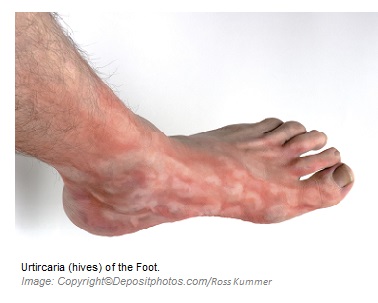skin eruptions.

The skin lesions are called wheals and they typically appear as raised pink or red areas surrounded by a red or white halo. The skin eruptions are annular, round, figurate, or confluent. They blanch with pressure, vary in size, and can be induced by repeated scratching. Pathologically, there are local edema and redness in the upper layer of the skin.
Angioedema may occur with or without urticaria. Compared to urticaria, angioedema lesions occur in deeper subcutaneous tissues and are of longer duration with less itchy. It typically involves the upper respiratory tract (especially larynx), around the mouth, eyelids, gastrointestinal tract, and male genitalia.
Urticaria rarely lasts more than 48 hours. If the lesion lasts less than 6 weeks, it is called acute urticaria, and if it lasts more than 6 weeks, it is called chronic urticaria. The most common sites for urticaria are the extremities and face, and angioedema is often seen around the eyes and in the lips.
The most important mediator of urticaria and angioedema is histamine, which causes dilatation of small veins in superficial cutaneous and mucosal areas.
Potential causes of urticaria and angioedema are:
- Foods: fish, shellfish, eggs, peanuts, chocolate, strawberries, tomatoes, cow milk, cheese, raw meats, walnuts, and hazelnuts.
- Medications: aspirin, penicillin, sulfonamides, and histamine-releasing agents (morphine, codeine, polymyxins, and quinine).
- Infectious diseases: strep pharyngitis, sinusitis, hepatitis, viral infections, fungal infections, and parasites.
- Insect stings: bee bites, flea bites, and mite bites.
- Internal medical diseases: hypoactive thyroid, hyperactive thyroid, SLE (systemic lupus erythematosus), rheumatic fever, and juvenile rheumatoid arthritis.
- Cancers: leukemia, and lymphoma.
- Physical agents: cold, heat, solar, pressure, water, exercise, and vibration.
- Inhalant agents from animals: cat, and horse.
- Blood transfusion.
- Contact agents: hair dyes, food additives and preservatives, and cosmetic products.
- Hormonal changes: pregnancy, and prior to menstruation.
- Genetic.
- Unknown (idiopathic).
Nutritional Supports:
Restricted Foods:
- Chocolate and sweets.
- Fish, shellfish, eggs, and raw meats.
- Nuts, especially peanuts, walnuts, and hazelnuts.
- Strawberries.
- Eggplants.
- Tomatoes.
- Cow milk.
- Cheese.
- Saturated, and Trans fats.
- Carbonated beverages.
- Refined foods.
- Process foods.
- Food colorings, flavourings, additives and preservatives. They are common sources of allergies.
- MSG (monosodium glutamate)-containing foods.
- Any allergenic foods not listed here.
Recommended Foods:
- Drink plenty of water: at least 2 liters a day.
- Gluten free grains.
- Lean protein: turkey and chicken.
- Fresh vegetables.
- Flaxseeds.
- Foods high in omega-3: flaxseeds, chia, and hemp seeds.
- Fruits and vegetables high in flavonoids: berries (except the causative agents), grapefruit, pomegranate, sea buckthorn, persimmon, kiwi, beets, basil, garlic, parsley, radish, radicchio, rhubarb and parsnips. Flavonoids especially quercetin may alleviate symptoms of allergies.
- Turmeric.
- Ginger.
- Pineapple.
- Green tea.
Recommended Supplements:
- Quercetin: 2000– 3000 mg a day. This flavonoid may reduce symptoms of allergy.
- French Maritime Pine Bark Extract: 100 – 200 mg a day. It is a powerful flavonoid that has antioxidant, anti-inflammatory, and immune boosting activities.
- Grape Seed Extract: 50 – 100 mg a day.
- Aloe Vera Juice: ¼ to ½ cup three times a day.
- Aloe Vera Gel: apply topically 2 to 3 times a day onto the lesions.
- Omega – 3 Fatty Acids: 2 – 3 grams a day. They reduce inflammation.
- Betaine HCL: 600 -1200 mg a day.
- Vitamin C: 2 – 3 grams a day.
- Bromelain: 1500 mg a day.
- Curcumin: 1000 – 1500 mg a day. It is a strong antioxidant that supports liver function, and fights inflammation
- Licorice Root Extract (containing 10% glycyrrhizin): 500 – 1000 mg a day. It has an anti-inflammatory activity.
- Butterbur Extract (containing 15% petasin): 150 – 300 mg a day.
- Tylophora: dried leaf 200 – 400 mg a day, or tincture 1 – 2 ml a day. The active ingredient in this herb is tylophorine, which has anti-inflammatory and anti-allergic properties.
- Thymus Extract: 500 – 1000 mg a day. Thymus extract is derived from the thymus gland of cows and improves immune function. It is used in allergies, hay fever, asthma and bronchitis.
- Digestive Enzymes: A full spectrum product.
- Probiotics: A product that provides 5 to 10 billion active organisms per serving.
Miscellaneous Suggestions:
- Liver detoxification.
- Colon cleansing.

